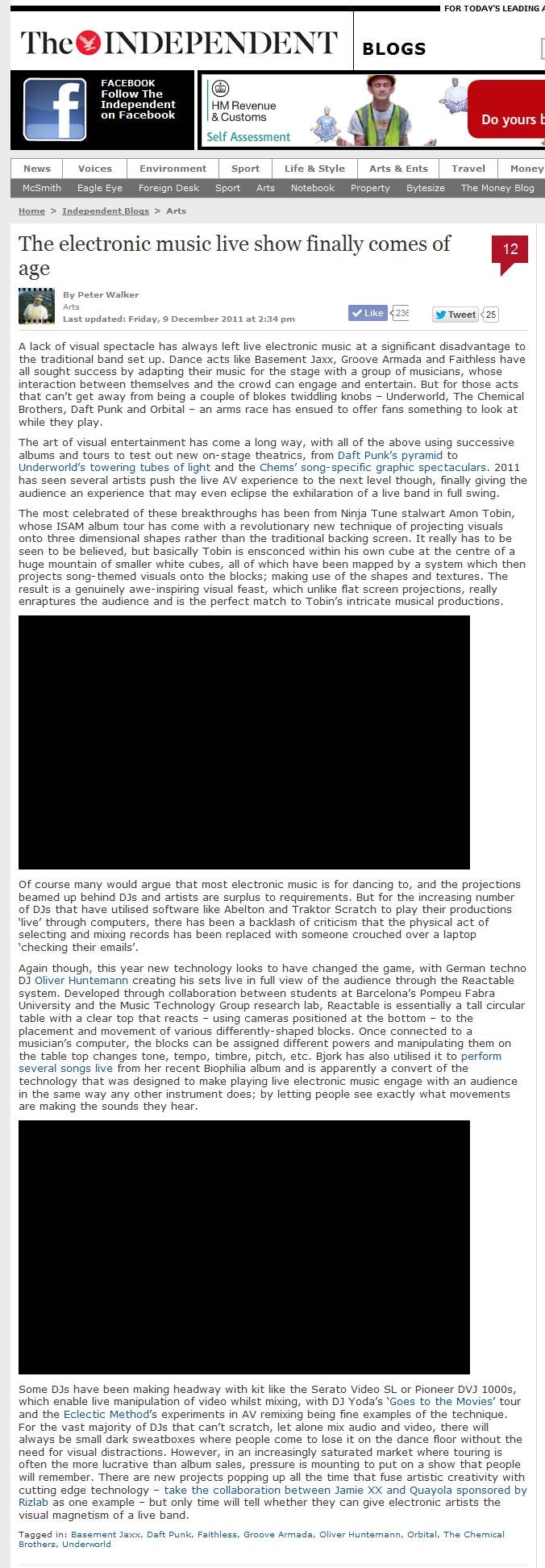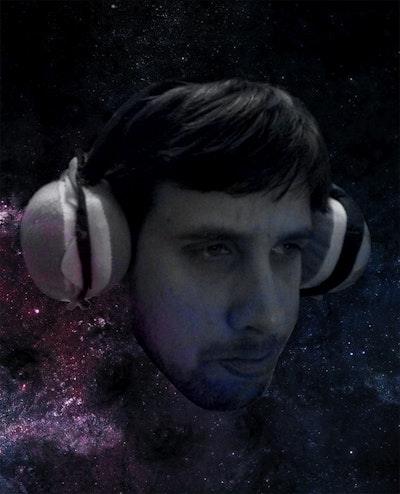The Electronic Music Live Show Comes of Age
The Independent

A lack of visual spectacle has always left live electronic music at a significant disadvantage to the traditional band set up. Dance acts like Basement Jaxx, Groove Armada and Faithless have all sought success by adapting their music for the stage with a group of musicians, whose interaction between themselves and the crowd can engage and entertain. But for those acts that can’t get away from being a couple of blokes twiddling knobs – Underworld, The Chemical Brothers, Daft Punk and Orbital – an arms race has ensued to offer fans something to look at while they play.
The art of visual entertainment has come a long way, with all of the above using successive albums and tours to test out new on-stage theatrics, from Daft Punk’s pyramid to Underworld’s towering tubes of light and the Chems’ song-specific graphic spectaculars. 2011 has seen several artists push the live AV experience to the next level though, finally giving the audience an experience that may even eclipse the exhilaration of a live band in full swing.
The most celebrated of these breakthroughs has been from Ninja Tune stalwart Amon Tobin, whose ISAM album tour has come with a revolutionary new technique of projecting visuals onto three dimensional shapes rather than the traditional backing screen. It really has to be seen to be believed (video explanation here) but basically Tobin is ensconced within his own cube at the centre of a huge mountain of smaller white cubes, all of which have been mapped by a system which then projects song-themed visuals onto the blocks; making use of the shapes and textures. The result is a genuinely awe-inspiring visual feast, which unlike flat screen projections, really enraptures the audience and is the perfect match to Tobin’s intricate musical productions.
Of course many would argue that most electronic music is for dancing to, and the projections beamed up behind DJs and artists are surplus to requirements. But for the increasing number of DJs that have utilised software like Abelton and Traktor Scratch to play their productions ‘live’ through computers, there has been a backlash of criticism that the physical act of selecting and mixing records has been replaced with someone crouched over a laptop ‘checking their emails’.
Again though, this year new technology looks to have changed the game, with German techno DJ Oliver Huntemann creating his sets live in full view of the audience through the Reactable system. Developed through collaboration between students at Barcelona’s Pompeu Fabra University and the Music Technology Group research lab, Reactable is essentially a tall circular table with a clear top that reacts - using cameras positioned at the bottom - to the placement and movement of various differently-shaped blocks. Once connected to a musician’s computer, the blocks can be assigned different powers and manipulating them on the table top changes tone, tempo, timbre, pitch, etc. Bjork has also utilised it to perform several songs live from her recent Biophilia album and is apparently a convert of the technology that was designed to make playing live electronic music engage with an audience in the same way any other instrument does; by letting people see exactly what movements are making the sounds they hear.
Some DJs have been making headway with kit like the Serato Video SL or Pioneer DVJ 1000s, which enable live manipulation of video whilst mixing, with DJ Yoda’s ‘Goes to the Movies’ tour and the Eclectic Method’s experiments in AV remixing being fine examples of the technique. For the vast majority of DJs that can’t scratch, let alone mix audio and video, there will always be small dark sweatboxes where people come to lose it on the dance floor without the need for visual distractions.
However, in an increasingly saturated market where touring is often the more lucrative than album sales, pressure is mounting to put on a show that people will remember. There are new projects popping up all the time that fuse artistic creativity with cutting edge technology – take the collaboration between Jamie XX and Quayola sponsored by Rizlab as one example – but only time will tell whether they can give electronic artists the visual magnetism of a live band.
